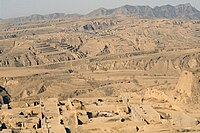
Photo from wikipedia
Abstract Chinese eolian deposits have been investigated intensively to reconstruct East Asian monsoon changes at tectonic to millennial timescales. However, high-resolution elemental proxies sensitive to rapid monsoon changes remains sparse.… Click to show full abstract
Abstract Chinese eolian deposits have been investigated intensively to reconstruct East Asian monsoon changes at tectonic to millennial timescales. However, high-resolution elemental proxies sensitive to rapid monsoon changes remains sparse. Here we present multiple elemental ratios of the Linxia loess sequence generated by scanning and conventional X-ray fluorescence (XRF) to assess East Asian monsoon variability at glacial-interglacial to sub-orbital timescales. The results show that 11 elements (Al, Si, K, Ca, Ti, Mn, Fe, Rb, Sr, Zr and Ba) can be reliably measured by XRF scanning of loess cores, albeit with relatively lower precision and increased noise levels (due to variable water content and matrix effects) when compared to XRF scanning of dry and homogenized powder samples. Seven elements (Ca, Fe, Ti, Mn, Zr, Rb and Sr), measured by XRF scanning of the core face and powder samples show high correlation (R2 > 0.7, n = 100) with those measured by conventional XRF methods, and thus can be considered as robust indicators for chemical weathering and grain-size sorting. We employ element ratios of Ca/Ti and Rb/Sr to reflect precipitation-induced weathering intensity, and the Zr/Rb ratio and mean grain size to infer the sorting effects related to winter-monsoon winds. These element ratios exhibit significant glacial-interglacial fluctuations, similar to records of magnetic susceptibility and mean grain size. Precessional- to millennial-scale monsoon changes are also persistent in our high-resolution elemental proxies, consistent with those in Gulang loess elemental ratios and Hulu/Sanbao speleothem δ18O records. Our results suggest that high resolution XRF scanning elemental ratios of Chinese loess have great potential for evaluating co-evolution of orbital- and millennial-scale monsoon variations.
Journal Title: CATENA
Year Published: 2021
Link to full text (if available)
Share on Social Media: Sign Up to like & get
recommendations!